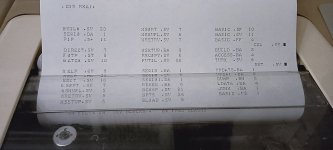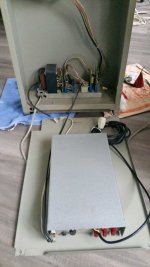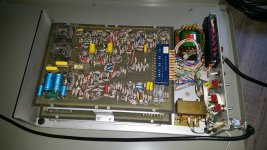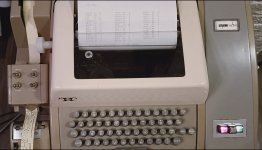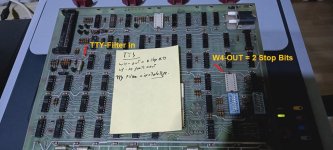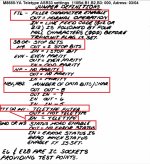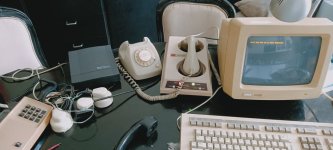MauriceH
Experienced Member
Hello all,
Back again and playing with my PDP8/M with RX02-Emulation project v4 AK6DN, normally run with VT220 terminal.
As I have a great working Teletype ASR33,I now manage to connect through a modem-line connection.
That is the Teletype is downstairs, the PDP8 upstarts.
So have a small Telephone home-exchange, some telephones and some very old modem.
The ASR-33 is original equipped with a 200Bd modem, designed by University school of LEUVEN(Belgium).
Back in the 1970's.
Have spoken with old employ man of that firm who converted these machines ,mine fully original to that rebuild.
Inside all extra PCB's Transformers etc, all due to this modem conversion.
A motor 15min time out, and auto start up motor after some DATA code , a 20mA-to-RS232 conversion, 3 switches to pick-up telephone line and a local print stop switch.
X-on/X-OFF function to remote start-stop puncher
etc.
Teletype it self does not have issues as far as I tested it over period of time.
Punching, reading tapes, and running it directly with the VT220 terminal.
Machine is quit in a mint condition.
Question for help:
So this year I got a second exact same MODEM, what a great find.
Hook up the both through a home telephone exchange for 6 phones.
First try with just a terminal VT220 at110 Bd, modem 1, telephone exchange, Modem 2 in the Teletype 33.
That is working like a charme, no failures etc.
Then hook up all to the PDP8/M.
Sofar connection is made and I can give commands and receive the output from the PDP8.
Done with Serial card M8655 at 110Bd.
Full wired RS232 cable to Modem.
Running OS8 on the RX02-Emulation-project, normally that runs fine on the VT220.
But then after f.i. a DIR command, the ASR33 looses track in print out.
The timing point of that failure is at the same lines after several attempts of same DIR command at same disk.
(Also with a second serial card M8650 at 110Bd, same failure at same lines in the printout.
4th line and 8th line in de directory listing.
12th line is again good.
4th "CCL .SV * then rest of that line is printed at the end of carradge.
8th "SET .SV * then rest of that line is printed at the end of carradge.
Is there some special settings in OS8 for a Real Teletype?
Regards
Maurice
Netherlands.
Back again and playing with my PDP8/M with RX02-Emulation project v4 AK6DN, normally run with VT220 terminal.
As I have a great working Teletype ASR33,I now manage to connect through a modem-line connection.
That is the Teletype is downstairs, the PDP8 upstarts.
So have a small Telephone home-exchange, some telephones and some very old modem.
The ASR-33 is original equipped with a 200Bd modem, designed by University school of LEUVEN(Belgium).
Back in the 1970's.
Have spoken with old employ man of that firm who converted these machines ,mine fully original to that rebuild.
Inside all extra PCB's Transformers etc, all due to this modem conversion.
A motor 15min time out, and auto start up motor after some DATA code , a 20mA-to-RS232 conversion, 3 switches to pick-up telephone line and a local print stop switch.
X-on/X-OFF function to remote start-stop puncher
etc.
Teletype it self does not have issues as far as I tested it over period of time.
Punching, reading tapes, and running it directly with the VT220 terminal.
Machine is quit in a mint condition.
Question for help:
So this year I got a second exact same MODEM, what a great find.
Hook up the both through a home telephone exchange for 6 phones.
First try with just a terminal VT220 at110 Bd, modem 1, telephone exchange, Modem 2 in the Teletype 33.
That is working like a charme, no failures etc.
Then hook up all to the PDP8/M.
Sofar connection is made and I can give commands and receive the output from the PDP8.
Done with Serial card M8655 at 110Bd.
Full wired RS232 cable to Modem.
Running OS8 on the RX02-Emulation-project, normally that runs fine on the VT220.
But then after f.i. a DIR command, the ASR33 looses track in print out.
The timing point of that failure is at the same lines after several attempts of same DIR command at same disk.
(Also with a second serial card M8650 at 110Bd, same failure at same lines in the printout.
4th line and 8th line in de directory listing.
12th line is again good.
4th "CCL .SV * then rest of that line is printed at the end of carradge.
8th "SET .SV * then rest of that line is printed at the end of carradge.
Is there some special settings in OS8 for a Real Teletype?
Regards
Maurice
Netherlands.

